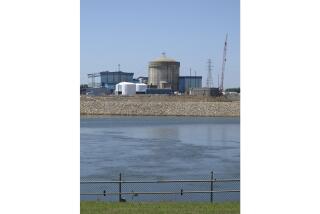Workers’ Lives Imperiled, House Panel Says : A-Arms Production Sites Called Unsafe
- Share via
WASHINGTON — The Energy Department’s principal production facilities for nuclear weapons are riddled with safety problems that endanger the lives of nuclear workers, the health of surrounding populations and the security of the nation’s nuclear arms systems, a House investigative panel said Thursday.
The Reagan Administration’s nuclear weapons buildup has created “a failed safety program” as the nation’s aging weapons complex struggles to keep up with the Pentagon’s demands, said Rep. Ron Wyden (D-Ore.), a member of the House Energy and Commerce Committee’s investigations and oversight subcommittee, which announced the results of its probe.
“Safety and weapons production goals invariably come into conflict at DOE’s decrepit facilities,” Wyden said. “But DOE trusts its contractors to put safety first, even when their fees often reward higher weapons production over safety.”
Agency Self-Regulating
Wyden is the author of a measure that would put the department’s nuclear weapons production complex under the oversight of an independent agency. While the Nuclear Regulatory Commission regulates the nation’s commercial nuclear energy program, the Energy Department has been essentially self-regulating, critics say, and has permitted safety and management shortcuts that are prohibited at the nation’s commercial facilities.
Wyden’s is one of several such proposals under consideration in the House and Senate.
The National Academy of Sciences, asked by the Energy Department to study the safety problems of the U.S. nuclear weapons facilities in the wake of the Soviets’ Chernobyl disaster, is expected to make a similar recommendation when it issues its findings next Thursday.
An Energy Department spokesman acknowledged that there have been problems at the facilities.
“Aggressive oversight . . . and attention to the letter and the spirit of environmental safety and compliance has not been consistently applied in the past,” said Mary L. Walker, assistant energy secretary for environment, safety and health. “We are in the process of positive changes. We have not yet arrived.”
Safety Deficiencies Cited
The House panel detailed several safety deficiencies at three of the department’s principal nuclear facilities--the Savannah River Complex in South Carolina, Washington’s Hanford Nuclear Reservation and the department’s Albuquerque Operations Center.
Witnesses involved in the projects told the House panel Thursday that several of their safety warnings went unheeded by private companies that manage the nuclear facilities under a DOE contract. They testified that managers argued that production quotas and delivery schedules would not permit the proposed precautions.
Among the faults uncovered in the House investigation were safety inspectors at several facilities who had failed certification tests and falsified their credentials.
James W. Simpkin, a Hanford quality assurance inspector, testified that pressure tubes in the plant’s nuclear reactor were not being properly inspected. The failure of the pressure tubes could cause a serious nuclear accident at the unit, which, like the Soviets’ Chernobyl reactor, has no containment wall to limit the spread of radiation.
Production Pressures
“What I saw was that production pressures gave them incentives to cover up” the problem,” Simpkin said.
One facility at the Energy Department’s Savannah River Plant was found to have no working sprinkler system to fight fires. While the management of the department’s one-of-a-kind tritium-production facility at Savannah had a sprinkler system installed, investigators found that it had not been hooked up to a water supply.
“If we were to have a major problem with that facility, it would in time put this nation’s nuclear deterrent at risk,” testified Troy E. Wade, the DOE’s acting assistant secretary for defense projects.
More to Read
Sign up for Essential California
The most important California stories and recommendations in your inbox every morning.
You may occasionally receive promotional content from the Los Angeles Times.














